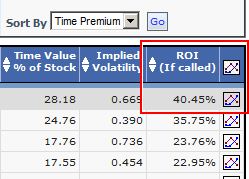The basic covered call is a relatively simple strategy. The owner of a security sells the right to have their security purchased at a predetermined price in the future in return for money now. If the security price does not fall over the life of the option, the call writer will keep the premium collected when the call was sold. The call writer's profit is limited in exchange for the premium.
Strategies for covered call writing depend on the objective.
- Supplement Return
Covered call writers interested in supplementing the return of existing holding will tend to sell covered calls out of the money. The expectation is not that the security price will rise, but that it will not fall. The seller of out of the money calls often expects to continue holding the security, but hopes to reap some extra return from the proceeds of selling the call.
- Hedge Against Loss
Covered call writers can protect against downside price movement by selling in the money calls. This is commonly done after a rise in a security that is already held, to protect some of the gains that were already made. Although less time premium is collected on the call, the risk of loss is lessened by the amount that the call is in the money.
- Speculative Strategies
There are strategies that set objectives such as Doubling in 2 Years, or earning 10% a Month. A portfolio can be doubled in two years by successively selling covered calls that return 50% time premium for a term that last approximately 1 year. It is also possible to sell covered calls that return 10% in approximately one month. Both of these strategies require that the underlying stock price is at or above the strike price at expiration, and that this goal can be achieved repeatedly. Theoretically, a stock will lose some value 50% of the time.
Covered Calls that fulfill these strategies can be identified easily using the Covered Call Screener. Simply select the desired month from the Expiration menu and Sort By Time Premium. The calls that yield the highest return relative to the underlying stock price will be displayed.
- Risks of Covered Call Writing
Writing covered calls is generally considered a conservative option strategy. This only holds true if covered calls are written on conservative stocks. The covered call writer will suffer losses if the underlying security price drops. The most significant measure of this risk is the volatility. Writing covered calls on stocks with low volatility is conservative. Writing covered calls on highly volatile stocks is inherently more risky.
- Effect of Dividends on Calls
When a stock pays a dividend, the price of the stock is reduced by the amount of the dividend. For example, if Frontline (FRO) closes at 41.50 and pays a $2.00 dividend, the open price will be adjusted downward prior to the open to $39.50. There may appear to be an advantage to the call writer, since it is known that the price of the stock will drop. Why not sell the $40 call when it is known that the stock will drop $2? The short answer is that the call is discounted to reflect the impending drop in the stock price. To illustrate this, use the option calculator to calculate the price of the stock that pays a dividend. Be sure to enter a dividend amount and a future dividend date that occurs before the option expires. More on Dividends and Calls.


